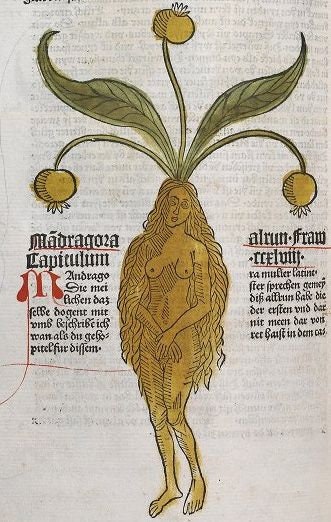

From the season in which this mandrake blossoms and ripens its fruit, one might form a conjecture that it is Rachel's dudaim(mandrakes). Hasselquist also seems inclined to consider this the plant referred to, for, when at Nazareth, he says, 'what I found most remarkable in their villages was the great quantity of mandrakes that grew in a vale below it. The fruit, when ripe in the beginning of May, is of the size and color of a small apple, exceedingly ruddy, and of a most agreeable odor our guide thought us fools for suspecting it to be unwholesome.' Maundrell was informed by the chief priest of the Samaritans that it was still noted for its genial virtue. The flowers are purple, and the root is for the most part forked. It grows low, like lettuce, to which its leaves have a strong resemblance, except that they have a dark green color.

John in the mountains,' says Mariti, 'about six miles south-west from Jerusalem, this plant is found at present, as well as in Tuscany. The plant referred to is probably mandragora. From the notices given in these passages of their qualities it is evident that mandrakes were collected in the fields, that they were fit for gathering in the wheat harvest in Mesopotamia, where the first occurrence took place that they were found in Palestine that they or the plants which yielded them diffused a peculiar odor, and that they were supposed to be possessed of aphrodisiac powers, or of assisting in producing conception. This word only occurs in two places of Scripture first in Gen 30:14-16 and secondly, in Son 7:13.
#MANDRAKE FRUIT IN BIBLE PROFESSIONAL#
Before using or ingesting ANY herb or plant for medicinal purposes or otherwise, please consult a physician, medical herbalist or other suitable professional for advice.Mandrake - Popular Cyclopedia Biblical Literature Mandrake was thought to crop up under gallows, wherever the body fluids of condemned prisoners landed on the ground.ĭisclaimer: The content of this article is for educational and gardening purposes only. The root is long and branched to pull it up is still considered unlucky (compare Josephus, BJ, VII, vi, 3). The plant has a rosette of handsome dark leaves, dark purple flowers and orange, tomato-like fruit.
#MANDRAKE FRUIT IN BIBLE HOW TO#
Because of the risk, there were many rituals surrounding how to protect oneself when harvesting mandrake.Hearing that scream was believed to be fatal (not true, of course). The human shape of the mandrake root supposedly screams when pulled from the ground.The fact that the roots resemble the human form and have narcotic properties is likely what led to the belief in the plant’s magical properties.Most common and well-known myths about mandrake from earlier times: Revolve around it having magical, often menacing powers.

The legendary stories about mandrake are interesting and They also spread the lore and use of the plant The Romans continued most of the medicinal uses that the It was in Greece that the resemblance of the roots It was used medicinally for anxiety and depression, insomnia, and gout. In Ancient Greece, mandrake was noted for being a narcotic. In the story, Rachel used the berries of the plant to conceive a child. One of the oldest references to mandrake is from the Bible and probably dates to 4,000 B.C. The ancient Hebrews called the mandrake dudiam, love apple because of the plants fruit and its reputation for increasing fertility and sexual arousal. It is a perennial herb with a large root and poisonous fruits. Mandrake is native to the Mediterranean region. Were all aware of mandrake and all believed the plant had magical powers, not Ancient Romans, Greeks, and Middle Eastern cultures The history of mandrake plants and their use and legends The fascinating history of this plant is colorful and even popped up in the Harry Potter series. Beginning in ancient times, the stories about mandrake included magical powers, fertility, possession by the devil, and more. Known more commonly as mandrake, the lore generally refers to the roots. Mandragora officinarum is a real plant with a mythical past.


 0 kommentar(er)
0 kommentar(er)
